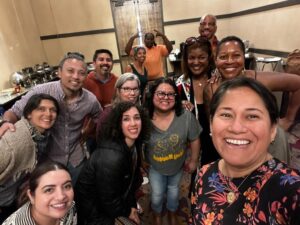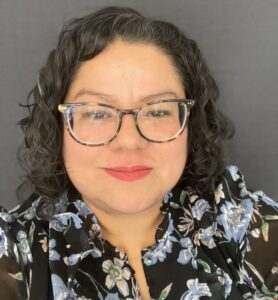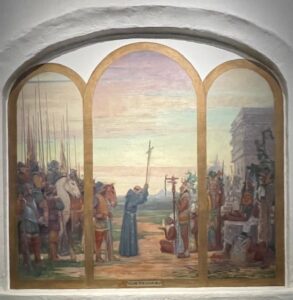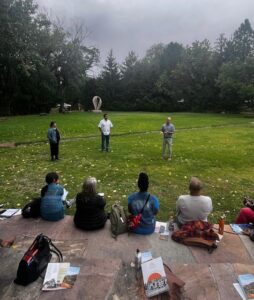BY Maria Aquino, Senior Program Officer on the Priority Communities Initiative at The James Irvine Foundation, and 2023 PLACES Fellow
During the third PLACES site visit, our cohort ventured into the Southwest to Santa Fe, N.M. In the PLACES tradition, our first day provided some foundational context about the city, which was led by City of Santa Fe historian and author of Environmental Justice in New Mexico, Valerie Rangel. Valerie used an innovative community-informed ArcGIS Storymaps tool to walk us through the region’s history using images and narrative. We learned a more accurate storytelling of the multiple invasions and genocide this part of the country has experienced, and the many faces of white supremacy that continue to be glorified with bronze emblems memorializing the ideology of colonization. Yet, the region’s history began long before any Europeans brutally claimed rights to its land, and situating the story with Indigenous people at the vanguard is an act of resistance and liberation that Valerie intentionally located within the timeline and geography of the story maps.
The mural in the picture, which celebrates colonialism, adorns the walls of the St. Francis Auditorium at the New Mexico Museum of Art in Santa Fe. Fellows learned about local efforts to foster a collaborative creative community and
support people, ideas, and art forms that are underrepresented in Santa Fe’s art scene.
Despite its history, Santa Fe has also been the setting of survival, resilience, culture, and healing, particularly within its Tribal nations. That is what the PLACES journey has shown us overall, as we have journeyed to various battlegrounds where the forces of racism are fought by everyday heroes who are building a future of solidarity and belonging. Santa Fe was no different, and during our trip we met with foundations and nonprofit partners working to shift power, build multi-racial solidarity, promote radical inclusion, and honor Indigenous sovereignty.
Changing Philanthropy & Trusting Indigenous Leaders
After our historical grounding, we ventured outdoors to the Glenn Green Galleries. In the garden we were surrounded by sculptures and pine trees, where we heard from James Calabaza of Trees, Water, People, JoAnn Melchor, CEO of the New Mexico Foundation (NMF), and Garrett Altmann from the Environmental Policy Innovation Center (who partners with the Santa Clara Pueblos.) JoAnn shared that despite having over 20 years of experience in nonprofit work, her leadership was questioned from the start, which is demonstrative of the change that is still needed in philanthropy to trust leaders of color. JoAnn understands that being from the community means she is not only accountable to the foundation, but more powerfully to her own community. Trusting leaders of color can create transformational change, especially when they in turn trust and implement the solutions generated by communities that experience the systemic inequities philanthropy seeks to address.
When JoAnn joined NMF as CEO, she demonstrated early on that being from the community meant she would bring significant changes. At the onset, she convened all the Tribal nations in New Mexico to hear how they reimagined partnering with the foundation. NMF practiced trust-based philanthropy, designating funding to implement community-identified priorities. They onboarded Indigenous woman-led, Roanhorse Consulting and formed a grant review committee comprised of community members. On the administrative side, they decreased grant proposals to one or two pages and shifted to culturally responsive reporting, such as poetry, video, and storytelling. These culture and practice changes put power back in the hands of grantees so that they could focus on the transformative work they do daily.
Culturally Affirming Philanthropy
As a queer Latine woman of Indigenous ancestry, our second day was one of my most culturally affirming experiences in philanthropy. A panel highlighting the LGBTQIA2S+ community shared their advocacy and movement building efforts in the state. We met co-founders of Indigenous Ways, Elena Higgins and wife, Tash Terry, who set the tone with a song about Indigenous wisdom about what connects us to each other. They spoke about the power of love as a force to disrupt systems, serving as an antidote to hate and division, while promoting healing. Indigenous Ways educates people about certain ancestors’ views that recognize 5 genders and see queer people as healers. We also heard from T. Michael Trimm, executive director at the Transgender Resource Center of New Mexico, who practices intersectional equity by uplifting trans, nonbinary and gender nonconforming people through advocacy, direct services, and trans cultural fluency education throughout the nation.
PLACES Fellows met with local leaders from the Pueblo of Santa Clara, Trees Water, People, and New Mexico Foundation to
learn how trust-based philanthropy can create a rebalance of power when engaging with Indigenous communities and honoring Indigenous sovereignty.
We then joined a panel of artists of colors, Rashaan Ahnad (Vital Spaces & Earthseed Black Arts Alliance), Israel Francisco Haros (Alas de Agua), Ehren Kee Natay and Gabriela Gomez, senior director of Meow Wolf Foundation. The artists opened up about the challenges of being artists of color in the region, where inclusion can be performative, and racism often limits their access to funding. In sharing their stories, I could see how distressing these experiences of exclusion are, as the artists contend with the rising cost of housing and gentrification, making it hard to stay in Santa Fe. Paradoxically, we also heard about the hardship of being a funder with limited resources dedicated to supporting artists of color, despite intending to resource the work more holistically.
Israel articulated the complex environment they navigate as one in which three forms of white supremacy are persistent; white supremacy, liberal white supremacy, and white Hispanic supremacy (which allies itself with Spanish European colonizers). There was a turning point in the conversation when a PLACES Fellow named the tension between the artists’ struggles and philanthropy’s space of privilege where funding often excludes them and goes to larger art institutions. Acknowledging this inequity allowed us to shift into a more honest conversation about how philanthropy has perpetuated white supremacy and further marginalized BIPOC artists. In a space of truth telling and authentic listening we stepped into bearing witness to the damage that unbalanced power dynamics in philanthropy has caused.
Racism and Healing
Throughout the Santa Fe trip I sensed a likeness to my only previous visit to the Southwest as a teenager, when our family caravanned to Guadalajara one summer. We drove from California through Arizona, New Mexico, and Texas before crossing south of the border. While passing Arizona, a white man yelled at me and my cousins, “Go home wetbacks.” He used the derogatory term for people who cross the Rio Grande to the U.S. My cousins, who are half Navajo, yelled back expletives at the man letting him know he was the one on foreign land. Though I felt vindicated by my cousins’ response, that experience colored my view of the Southwest. In Santa Fe, no one yelled at me to “go back home,” but I still got the message, just as I did in Arizona long ago, that people who look like me are not welcome.
Even so, I am fully aware that anti-Indigenous and anti-Black racism is not unique to the Southwest, without a doubt it is white supremacist ideology that led to the creation of this country and shaped its systems. This is systemic, yet it is also personal, and it saddened me to reflect on the anti-Indigenous racism I’ve experienced in my own life, within my own culture and family. Colorism, rooted in white supremacy, has created profound wounds, and led many in my family to reject our Indigenous ancestry. Perhaps there was a time when it was necessary to survival, because of the violence of colonization, yet the hurt has continued for generations. White supremacist culture makes its way into every part of our lives, no matter where in this country we reside, and without acknowledging it, old wounds continue to run deep, and new ones get created. While there is still much work needed to dismantle white supremacy within systems, I felt the gravity of the simultaneous work needed to heal from its harms.
 PLACES Fellows celebrating another great week of learning at the end of their visit to Santa Fe.
PLACES Fellows celebrating another great week of learning at the end of their visit to Santa Fe.
Santa Fe showed me that while racist sentiments are pervasive, there are leaders who are using art, song, storytelling, and cultural practices for healing and to create spaces that celebrate diversity, center racial justice, and build power. As we concluded our trip, Bina Patel left us with our ongoing assignment in philanthropy: to continuously reflect on how we are present for someone else’s grief, bear witness, and stand in solidarity. Philanthropy can be a difficult space to occupy, but within it we hold power and privilege that should be shared and relinquished to communities. Through PLACES we have been in community, among our fellows and the bridge building leaders we’ve met along the way. As we journey back to our offices, we are called on to use philanthropy for good by bringing more heart to the work and make progress towards liberation. For this I take with me the message that Elena and Tash offered, that love can be an antidote for division and a force for changing systems.
About the Author

Maria Aquino is a senior program officer on the Priority Communities Initiative at The James Irvine Foundation, focused on supporting a local economy that works for all by increasing access to quality jobs and ensuring community voices drive economic development. Maria is a member of TFN’s 2023 PLACES Cohort.


